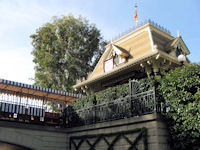
| Search |
| MyParkInfo |
| Register - FREE! |
| Login |
| Locate Park |
| Park Finder! |
| Listed By Name |
| Listed By State |
| Lookup On Map |
| Other Info |
| Beach Club Villas |
| Animal Kingdom Villas |
Home > News
| Dangling Above the Crocodiles, Disney's New Theme Park Adventure |
National Geographic Daily News
Original Article »April 06, 2011
There we were, creeping gingerly on a dilapidated rope bridge a few yards above hippos and crocodiles. “Stop shaking the bridge,” the person in front of me yelled as the bridge swung and shook. On the far side of the croc pool we could see elephants and antelope grazing on the savanna. Vultures surveyed the scene from baobab trees. Further along the road, several rhinos grazed and a lion sunned itself atop a kopje.
We were on safari–but not in Africa. We were animal spotting in the newest attraction in Walt Disney World’s Animal Kingdom, in Florida.
Wild Africa Trek opened a few weeks ago. Limited to 12 guests at a time, it’s an expedition on foot and safari vehicle through the Animal Kingdom’s Kilimanjaro Safarisattraction.
But whereas Kilimanjaro Safaris involves a ride through the “Harambe Wildlife Reserve,” seated on the back of an open-sided safari vehicle, Wild Africa Trek is something of an expedition, accompanied by two guides.
I was a little skeptical that the trek could be anything remotely like a real safari in Africa. A South African, I have been on the real thing many times, including serious foot patrols under armed escort through Big Five country in some of southern Africa’s most pristine wildernesses.
When we suited up for the Disney World experience in an obligatory jacket with a safety harness, it seemed a little excessive. After all, how dangerous could it be in the Animal Kingdom!
I didn’t disclose I worked for National Geographic and was somewhat familiar with what they were talking about. But I found the guides knew their subjects and were able to answer some curve ball questions I asked, such as the different conservation status of mountain and lowland gorillas.
Then we were ushered through a locked gate into the savanna. It’s true that the Kilimanjaro Safaris trucks were rolling constantly by, but for the most part we were out in the bush.
The guide paused at skulls of a hippo and a crocodile along the footpath, using them as props to tell us about the animals. Then our harnesses were clipped to overhead tracks and we were allowed to lean out over the hippo pool for an overhead view of the giant animals wallowing yards below.
Next we crossed a couple of rope bridges–built to look like they were about to collapse. But the structures were sturdy, although they bounced and swayed, and, besides, we were attached to an overhead track. The second bridge took us above the Nile crocodiles sunning themselves on rocks ten feet below. A great angle for photography, and not one you’d easily find in the wild in Africa.
The “dangerous” part of the safari over, we were allowed to remove the harnesses to board a vehicle that meandered across the savanna, using roads and stops off limits to the rumbling safari trucks.
A 30-minute stop at a “rest camp” overlooking a waterhole filled with flamingos followed. Elephants could be observed grazing in the distance.
The meal over, we sat for a while to watch the grazing elephants, giraffes and buck. I realized it certainly could have been in Africa, except that one seldom sees so many animals in one place in such a short period of time.
At the end of the three-hour Wild Africa Trek I had my verdict. It’s not Africa, but it’s a close as one could get to the mother continent. Disney World has done an incredible job of making it look like Africa, and the African animals are certainly real and strolling around as if they were on a real savanna.
The rope bridge above the crocodiles is a real thrill, and not something you would want to attempt anywhere without the safety harness.
But most importantly, for me, the guides were efficient and very knowledgeable about the animals and their natural African habitats. They even knew about the different African trees and the grazing habits of the different antelope.
The price for this experience is $180 per person, but when you spread it over three hours and include the gourmet meal, transportation, the services of the guides, plus a disc of the dozens of photographs the guides take of the animals and participants during the expedition, you realize it’s a pretty good deal. A real luxury safari in Africa can easily run $1,000 per day. And you may not see as many animals.
Part of the fee for the trek is given to the Disney Wildlife Conservation Fund. Each trek participant has a say in where the money goes: Big Cats, Elephants, White Rhinos, or the general Disney Wildlife Conservation Fund.
Copyright© 2011-2023 - Burketech. All Rights Reserved.
ParkInfo2Go is not affiliated with the Walt Disney Company, Universal Studios, Six Flags or
any of the other Theme and Amusement Park operators featured on this site.
